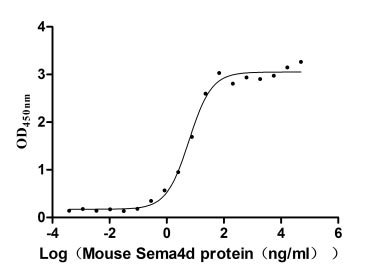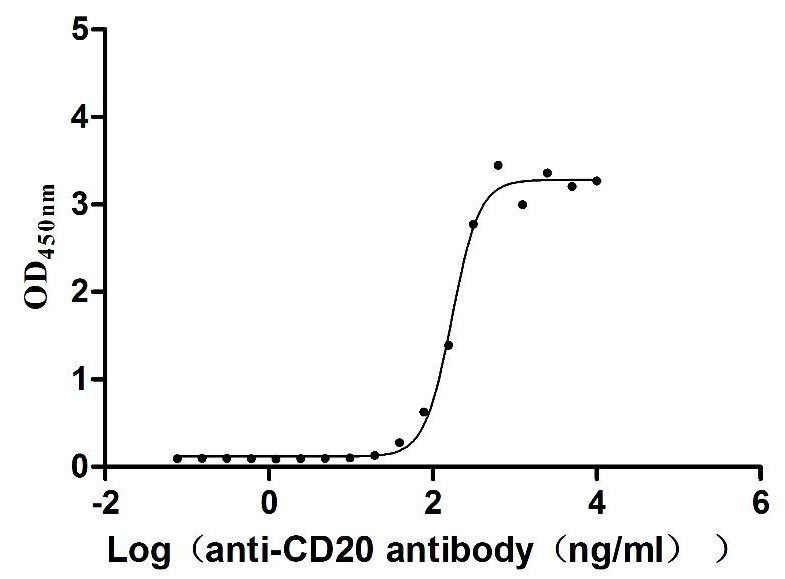Recombinant Mouse WNT1-inducible-signaling pathway protein 1 (Wisp1)
-
货号:CSB-YP026119MO
-
规格:
-
来源:Yeast
-
其他:
-
货号:CSB-EP026119MO
-
规格:
-
来源:E.coli
-
其他:
-
货号:CSB-EP026119MO-B
-
规格:
-
来源:E.coli
-
共轭:Avi-tag Biotinylated
E. coli biotin ligase (BirA) is highly specific in covalently attaching biotin to the 15 amino acid AviTag peptide. This recombinant protein was biotinylated in vivo by AviTag-BirA technology, which method is BriA catalyzes amide linkage between the biotin and the specific lysine of the AviTag.
-
其他:
-
货号:CSB-BP026119MO
-
规格:
-
来源:Baculovirus
-
其他:
-
货号:CSB-MP026119MO
-
规格:
-
来源:Mammalian cell
-
其他:
产品详情
-
纯度:>85% (SDS-PAGE)
-
基因名:
-
Uniprot No.:
-
别名:Ccn4; Elm1; Wisp1CCN family member 4; ELM-1; WNT1-inducible-signaling pathway protein 1; WISP-1
-
种属:Mus musculus (Mouse)
-
蛋白长度:Full Length of Mature Protein
-
表达区域:23-367
-
氨基酸序列TALSPTPT TMTFTPAPLE ETTTRPEFCK WPCECPQSPP RCPLGVSLIT DGCECCKICA QQLGDNCTEA AICDPHRGLY CDYSGDRPRY AIGVCAQVVG VGCVLDGVRY TNGESFQPNC RYNCTCIDGT VGCTPLCLSP RPPRLWCRQP RHVRVPGQCC EQWVCDDDAR RPRQTALLDT RAFAASGAVE QRYENCIAYT SPWSPCSTTC GLGISTRISN VNARCWPEQE SRLCNLRPCD VDIQLHIKAG KKCLAVYQPE EATNFTLAGC VSTRTYRPKY CGVCTDNRCC IPYKSKTISV DFQCPEGPGF SRQVLWINAC FCNLSCRNPN DIFADLESYP DFEEIAN
-
蛋白标签:Tag type will be determined during the manufacturing process.
The tag type will be determined during production process. If you have specified tag type, please tell us and we will develop the specified tag preferentially. -
产品提供形式:Lyophilized powder
Note: We will preferentially ship the format that we have in stock, however, if you have any special requirement for the format, please remark your requirement when placing the order, we will prepare according to your demand. -
复溶:We recommend that this vial be briefly centrifuged prior to opening to bring the contents to the bottom. Please reconstitute protein in deionized sterile water to a concentration of 0.1-1.0 mg/mL.We recommend to add 5-50% of glycerol (final concentration) and aliquot for long-term storage at -20℃/-80℃. Our default final concentration of glycerol is 50%. Customers could use it as reference.
-
储存条件:Store at -20°C/-80°C upon receipt, aliquoting is necessary for mutiple use. Avoid repeated freeze-thaw cycles.
-
保质期:The shelf life is related to many factors, storage state, buffer ingredients, storage temperature and the stability of the protein itself.
Generally, the shelf life of liquid form is 6 months at -20°C/-80°C. The shelf life of lyophilized form is 12 months at -20°C/-80°C. -
货期:Delivery time may differ from different purchasing way or location, please kindly consult your local distributors for specific delivery time.Note: All of our proteins are default shipped with normal blue ice packs, if you request to ship with dry ice, please communicate with us in advance and extra fees will be charged.
-
注意事项:Repeated freezing and thawing is not recommended. Store working aliquots at 4°C for up to one week.
-
Datasheet :Please contact us to get it.
靶点详情
-
功能:Downstream regulator in the Wnt/Frizzled-signaling pathway. Associated with cell survival. Adheres to skin and melanoma fibroblasts. In vitro binding to skin fibroblasts occurs through the proteoglycans, decorin and biglycan. Suppresses tumor growth in vivo.
-
基因功能参考文献:
- WISP1 interacts with PPARgamma and that this interaction results in the inhibition of PPARgamma activity. T PMID: 28496206
- WISP1 plays an aggravating role in the development of post-traumatic experimental OA. PMID: 28735021
- Data revealed that reconstituted overexpression of WISP-1 could largely reverse the Notch1-/--induced metastasis-promoting effect of mesenchymal stem cell-derived stromal fibroblasts (MSC-DF); thus, demonstrating that the Notch1-determined melanoma metastasis-regulating role of MSC-DF is mediated primarily by WISP-1. PMID: 27813493
- Upregulation of Wnt2 expression enhanced WISP-1 and promoted vascular smooth muscle cell migration and intimal thickening. PMID: 27199447
- One of the most striking new findings was up-regulation of mRNA for the matricellular protein WNT1-inducible signaling pathway protein 1 (CCN4) in metastatic cells; increased protein expression was verified by immunoblotting and immunocytochemistr PMID: 27807066
- the Bmp3/Wisp1 signaling pathway play a key role in mesenchymal stem cell proliferation, and consequently adipogenesis. PMID: 26489765
- the Wisp1-integrin beta6 pathway is inhibited by RGD peptides in septic mice, which protects against acute lung injury PMID: 25526379
- WISP1 is a novel regulator of bone turnover and Wnt signaling PMID: 25864198
- The data suggest that WISP1 may play a role in linking obesity to inflammation and insulin resistance and could be a novel therapeutic target for obesity. PMID: 25281430
- Wnt5a-induced Wnt1-inducible secreted protein-1 suppresses vascular smooth muscle cell apoptosis induced by oxidative stress. PMID: 25212236
- Notch1-induced WISP-1 expression appeared to be Wnt11-dependent, but Wnt1-independent PMID: 22715413
- WISP-1 exerts paracrine action on immune cells by inhibiting their response to IL12 PMID: 22777646
- WISP1 is an endogenous signal that acts through TLR4 signaling to increase alveolar-capillary permeability in ventilator-induced lung injury. PMID: 22700866
- WISP-1 has a positive influence on bone cell differentiation and function and may work by enhancing the effects of BMP-2 PMID: 20684029
- WISP-1 stimulates cardiomyocyte hypertrophy, fibroblast proliferation, and ECM expression in vitro. These results suggest that WISP-1 may play a critical role in post-myocardial infarction remodeling. PMID: 17616748
- Results show that NO increases WISP-1 expression, and suggest a new role for iNOS and NO in colitis. PMID: 19238344
- expression of WISP1 was increased in alveolar epithelial type II cells in a model of pulmonary fibrosis PMID: 19287097
显示更多
收起更多
-
亚细胞定位:Secreted.
-
蛋白家族:CCN family
-
组织特异性:Highly expressed in kidney and lung. Lower levels in heart, brain, spleen, liver, skeletal muscle and testis. Expressed in low metastatic melanoma cells.
-
数据库链接:
KEGG: mmu:22402
STRING: 10090.ENSMUSP00000005255
UniGene: Mm.10222
Most popular with customers
-
Recombinant Human Pro-neuregulin-1, membrane-bound isoform (NRG1), partial (Active)
Express system: Mammalian cell
Species: Homo sapiens (Human)
-
Recombinant Mouse Semaphorin-4D (Sema4d), partial (Active)
Express system: Mammalian cell
Species: Mus musculus (Mouse)
-
Recombinant Macaca fascicularis Claudin (CLDN18)-VLPs (Active)
Express system: Mammalian cell
Species: Macaca fascicularis (Crab-eating macaque) (Cynomolgus monkey)
-
Recombinant Dog B-lymphocyte antigen CD20 (MS4A1)-VLPs (Active)
Express system: Mammalian cell
Species: Canis lupus familiaris (Dog) (Canis familiaris)
-
Recombinant Macaca fascicularis CD44 antigen (CD44), partial (Active)
Express system: Mammalian cell
Species: Macaca fascicularis (Crab-eating macaque) (Cynomolgus monkey)
-
Recombinant Human Claudin-3 (CLDN3)-VLPs (Active)
Express system: Mammalian cell
Species: Homo sapiens (Human)
-
Recombinant Human Myosin regulatory light polypeptide 9 (MYL9) (Active)
Express system: Yeast
Species: Homo sapiens (Human)
-
Recombinant Mouse CUB domain-containing protein 1 (Cdcp1), partial (Active)
Express system: Mammalian cell
Species: Mus musculus (Mouse)


-AC1.jpg)

















